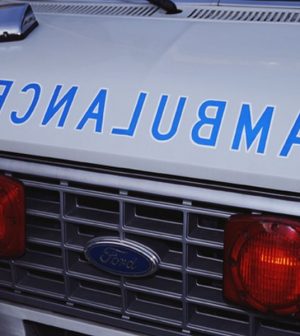- Navigating Your Midlife Crisis: Embracing New Possibilities
- City Raccoons Showing Signs of Domestication
- Mapping the Exposome: Science Broadens Focus to Environmental Disease Triggers
- One Week Less on Social Media Linked to Better Mental Health
- Your Brain Changes in Stages as You Age, Study Finds
- Some Suicide Victims Show No Typical Warning Signs, Study Finds
- ByHeart Formula Faces Lawsuits After Babies Sickened With Botulism
- Switch to Vegan Diet Could Cut Your Greenhouse Gas Emissions in Half
- Regular Bedtime Does Wonders for Blood Pressure
- Dining Alone Could Mean Worse Nutrition for Seniors
On-the-Road Help: ‘Mobile Stroke Units’ Are Saving People’s Lives

Time is never more precious than in the minutes after a stroke. Now, research is confirming that a “mobile stroke unit” can rush aid to patients quickly, potentially saving lives.
“Patients who are treated early benefit from a complete reversal of stroke symptoms and avoidance of disability,” said lead study author Dr. James Grotta. He is director of stroke research at the Clinical Institute for Research and Innovation at Memorial Hermann–Texas Medical Center, in Houston.. “This suggests that in the first hour after a stroke occurs, the brain is not yet irreversibly damaged and is very amenable to effective treatment.”
Mobile stroke units are special ambulances equipped to diagnose and treat stroke quickly.
When treating patients with ischemic stroke (caused by a clot blocking blood flow to the brain), these units can also immediately administer clot-dissolving tissue plasminogen activator (tPA) medication.
This study found that stroke patients treated by mobile stroke units received clot-busting medications faster and more often — and had significantly better recovery — than patients who received regular emergency care by standard ambulance.
For the study, the researchers analyzed data from 1,047 patients who were eligible for tPA and transported to hospital emergency departments by either mobile stroke units (617 patients) or standard ambulance (430 patients).
The hospitals were in Houston; New York City; Indianapolis; Los Angeles; Memphis, Tenn.; Aurora, Colo.; and Burlingame, Calif.
Overall, 97% of patients transported by a mobile stroke unit received tPA, compared to 80% of those brought to the emergency department by a regular ambulance.
One-third of patients transported by a mobile stroke unit were treated within one hour after stroke symptoms began, compared to 3% of patients transported by a standard ambulance, the findings showed.
Fifty-three percent of the mobile unit patients had recovered fully within three months, compared with 43% of standard ambulance-transported patients, according to the study presented Wednesday at an online meeting of the American Stroke Association.
“Our results mean that, on average, for every 100 patients treated on a mobile stroke unit rather than standard ambulance, 27 will have less final disability, and 11 of the 27 will be disability-free,” Grotta said in a meeting news release.
“But for this to happen, patients, caregivers and bystanders need to recognize the signs of stroke and call 911 immediately,” he added.
Research presented at meetings should be considered preliminary until published in a peer-reviewed journal.
More information
The U.S. Centers for Disease Control and Prevention has more on stroke treatment.
SOURCE: American Stroke Association, news release, March 17, 2021
Source: HealthDay
Copyright © 2025 HealthDay. All rights reserved.










